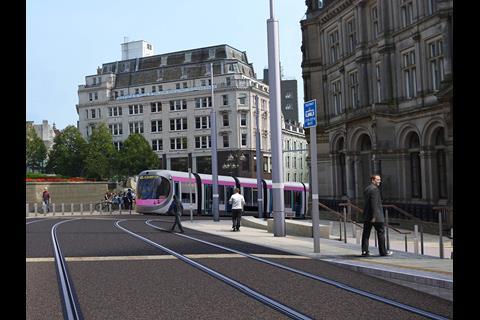UK: One of Midland Metro’s Urbos trams has been returned to CAF’s factory at Zaragoza in Spain where it is to be retrofitted with two lithium ion cells to enable to it to operate over short distances without catenary.
The Midland Metro would be the first modern commercial tramway in the UK with catenary-free running. This will avoid the need for the potentially disruptive and expensive installation of overhead electrification equipment, and help to protect architecturally sensitive areas around Birmingham’s Victoria Square.
The batteries will be fitted to the tram’s roof, and recharged by the overhead electrification on the other parts of the route. Midland Metro says CAF will undertake ‘exhaustive’ testing in Spain before the tram returns to the UK in the autumn. Further testing would then be carried out at the depot, before work begins on equipping the other 20 trams.
The battery project has been commissioned by the West Midlands Combined Authority which owns the Midland Metro. The total cost of fitting out the fleet will be a one-off £15·5m, but this expected to save £9·24m on infrastructure costs on the first four planned extensions to the network.
Catenary-free running is proposed for the following sections of the planned extensions:
- The whole of the Birmingham Centenary Square extension which is scheduled to open in 2019, including through Victoria Square;
- The Wolverhampton city centre extension between the bus and railway stations which is also due to open in 2019;
- The Birmingham – Edgbaston extension from Centenary Square to the Brindleyplace tram stop then through the underpass at Five Ways to Hagley Road, due to open in 2021;
- The Birmingham Eastside extension between Moor Street Queensway and Digbeth High Street stop, including under the proposed High Speed 2 station at Curzon Street. This extension is scheduled to open in 2023.
The proposed Wednesbury to Brierley Hill extension is also being evaluated to identify possible catenary-free sections.
Similar CAF Urbos 3 trams already run catenary-free along some sections of the networks in Zaragoza and Sevilla, using supercapacitors for on-board energy storage. However, supercapacitors were deemed to be unsuitable for the Midland Metro extension to Centenary Square, because of the steep hill on Pinfold Street.
‘Battery technology is now so developed we can use it to get the tram through sensitive areas and overcome what would otherwise be expensive infrastructure works’, said Councillor Roger Horton, lead member for rail and Metro on WMCA’s transport delivery committee. ‘This has got to be good news as the Midland Metro continues to expand and provide an effective alternative to the private car, helping to ease congestion and support economic growth.’





